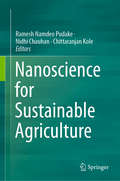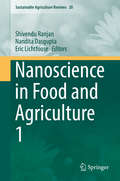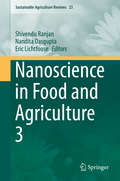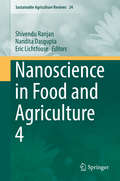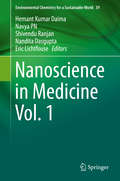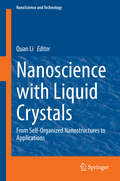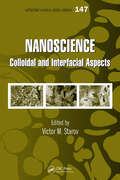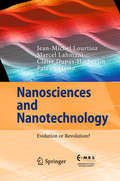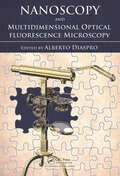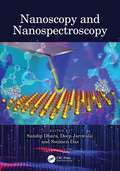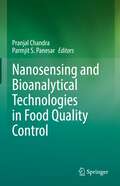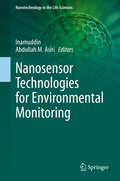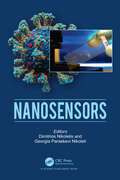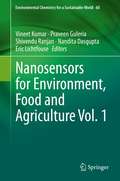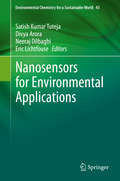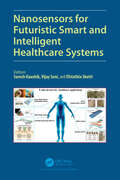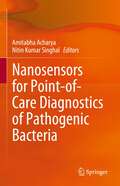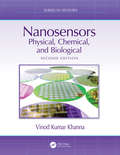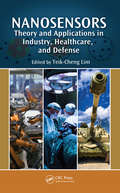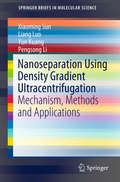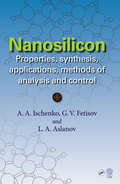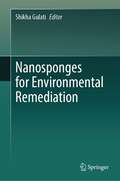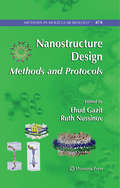- Table View
- List View
Nanoscience for Sustainable Agriculture
by Chittaranjan Kole Ramesh Namdeo Pudake Nidhi ChauhanThis book discusses the ability of nanomaterials to protect crop-plant and animal health, increase production, and enhance the quality of food and other agricultural products. It explores the use of targeted delivery and slow- release agrochemicals to reduce the damage to non-target organisms and the quantity released into the soil and water, as well as nanotechnology-derived tools in the field of plant and animal genetic improvement. It also addresses future applications of nanotechnology in sustainable agriculture and the legislative regulation and safety evaluation of nanomaterials. The book highlights the recent advances made in nanotechnology and its contribution towards an eco-friendly approach in agriculture.
Nanoscience in Food and Agriculture 2
by Eric Lichtfouse Shivendu Ranjan Nandita DasguptaThis book is the second volume on this topic within the series. With unique properties, nanomaterials are rapidly finding novel applications in many fields such as food, medicine, agriculture and pollution. Such applications include to treat cancer, nanosensors to detect food contamination, nanomaterials for food packaging, nanoencapsulation to preserve nutraceuticals, and nanofertilisers for advanced agriculture. After an introductory chapter on property rights of nanomaterials, readers will discover the applications of nanotechnology in food, health, environment, ecotoxicology and agriculture.
Nanoscience in Food and Agriculture 3
by Eric Lichtfouse Shivendu Ranjan Nandita DasguptaThis book is the third volume on Nanoscience in Food and Agriculture, published in the Sustainable Agriculture Reviews series. In this book we present ten chapters describing the synthesis and application of nanomaterials for health, food, agriculture and bioremediation. Nanomaterials with unique properties are now being used to improve food and agricultural production. Research on nanomaterials is indeed revealing new applications that were once thought to be imaginary. Specifically, applications lead to higher crop productivity with nanofertilisers, better packaging, longer food shelf life and better sensing of aromas and contaminants. These applications are needed in particular in poor countries where food is scarce and the water quality bad. Nanotechnology also addresses the age old issue of water polluted by industrial, urban and agricultural pollutants. For instance, research produces nanomaterials that clean water more efficiently than classical methods, thus yielding water for drinking and irrigation. However, some nano materials have been found to be toxic. Therefore, nanomaterials should be engineered to be safe for the environment.
Nanoscience in Food and Agriculture 4
by Eric Lichtfouse Shivendu Ranjan Nandita DasguptaIn this book we present ten chapters describing the synthesis and application of nanomaterials for health, food, agriculture and bioremediation. Nanomaterials, with unique properties are now being used to improve food and agricultural production. Research on nanomaterials is indeed revealing new applications that were once thought to be imaginary. Specifically, applications lead to higher crop productivity with nanofertilisers, better packaging, longer food shelf life and better sensing of aromas and contaminants. these applications are needed in particular in poor countries where food is scarce and the water quality bad. Nanotechnology also addresses the age old issue of water polluted by industrial, urban and agricultural pollutants. For instance, research produces nanomaterials that clean water more efficiently than classical methods, thus yielding water for drinking and irrigation. However, some nanomaterials have been found to be toxic. Therefore, nanomaterials should be engineered to be safe for the environment.
Nanoscience in Food and Agriculture 5
by Eric Lichtfouse Shivendu Ranjan Nandita DasguptaThis book presents comprehensive reviews on the principles, design and applications of nanomaterials in the food and agriculture sectors. This book is the fifth of several volumes on Nanoscience in Food and Agriculture, published in the series Sustainable Agriculture Reviews.
Nanoscience in Medicine Vol. 1 (Environmental Chemistry for a Sustainable World #39)
by Eric Lichtfouse Shivendu Ranjan Nandita Dasgupta Hemant Kumar Daima Navya PnThis book takes a systematic approach to address the gaps relating to nanomedicine and bring together fragmented knowledge on the advances on nanomaterials and their biomedical applicability. In particular, it demonstrates an exclusive compilation of state of the art research with a focus on fundamental concepts, current trends, limitations, and future directions of nanomedicine.
Nanoscience with Liquid Crystals
by Quan LiThis book focuses on the exciting topic of nanoscience with liquid crystals: from self-organized nanostructures to applications. The elegant self-organized liquid crystalline nanostructures, the synergetic characteristics of liquid crystals and nanoparticles, liquid crystalline nanomaterials, synthesis of nanomaterials using liquid crystals as templates, nanoconfinement and nanoparticles of liquid crystals are covered and discussed, and the prospect of fabricating functional materials is highlighted. Contributions, collecting the scattered literature of the field from leading and active players, are compiled to make the book a reference book. Readers will find the book useful and of benefit both as summaries for works in this field and as tutorials and explanations of concepts for those just entering the field. Additionally, the book helps to stimulate future developments.
Nanoscience: Colloidal and Interfacial Aspects (Surfactant Science)
by Victor M. StarovBringing together a prominent roster of 42 leading investigators and their teams, this volume details the wide range of theoretical and experimental knowledge that can be successfully applied for investigating nanosystems. The book provides researchers with a full examination of nano-disperse colloids, homogeneous and heterogeneous nano-structured materials (and their properties), and shelf-organization at the nano-scale. It explores non-linear lectrokinetic phenomena in nano-sized dispersions and nano-sized biological systems. It discusses application aspects of technological processes in great detail, offering scientists and engineers across all fields authoritative commentary on colloid and interface science operating at the nanoscale.
Nanosciences and Nanotechnology
by Jean-Michel Lourtioz Marcel Lahmani Claire Dupas-Haeberlin Patrice HestoThis book provides information to the state of art of research in nanotechnology and nano medicine and risks of nano technology. It covers an interdisciplinary and very wide scope of the latest fundamental research status and industrial applications of nano technologies ranging from nano physics, nano chemistry to biotechnology and toxicology. It provides information to last legislation of nano usage and potential social impact too. The book contains also a reference list of major European research centers and associated universities offering licences and master of nano matter. For clarity and attractivity, the book has many illustrations and specific inserts to complete the understanding of the scientific texts.
Nanoscopy and Multidimensional Optical Fluorescence Microscopy
by Alberto Diaspro"Alberto Diaspro has been choreographing light's dance for over 20 years, and in Nanoscopy and Multidimensional Optical Fluorescence Microscopy, he has assembled a diverse group of experts to explain the methods they use to coax light to reveal biology's secrets."- From the Foreword by Daniel Evanko, editor, Nature Methods Nanoscopy and Multidimens
Nanoscopy and Nanospectroscopy
by Sandip Dhara Deep Jariwala Soumen DasThis book builds a narrative on the near-field optical and spectroscopic studies with an emphasis on plasmonic- and photonic-assisted nano-optics as a tool for superlensing. Deliberations on near-field studies using confined light in various applications are included along with their commercial implications. Single-molecule detection utilizing efficient surface-enhanced Raman scattering phenomenon in the far-field and plasmonic tip-enhanced Raman scattering studies in the near-field measurements for fast analysis up to trace level is discussed. Features: Covers the broad area of nano-optical spectroscopy from the perspective of putting the concepts and innovations in the field to use. Discusses entire spectra of near-field optics and spectroscopy using light. Explores gas/chemical sensing using surface plasmon resonance (SPR) in the Kretschmann configuration. Includes dielectric nano-photonics and optical confinement. Studies phonon behaviour using confined light for the analysis of chemical, biological, and other materials. This book is aimed at graduate students and researchers in material science, analytical chemistry, nanotechnology, and electrical engineering.
Nanosensing and Bioanalytical Technologies in Food Quality Control
by Pranjal Chandra Parmjit S. PanesarThis book reviews applications of nanomaterial and nanodevices in the food industry. It also discusses the advanced bioanalytical techniques, including Enzyme-Linked Immunosorbent Assay (ELISA), immunoanalytical techniques, monoclonal antibody-based immunological techniques for detecting food adulterations and allergens. It comprehensively covers electrode modification and nano-engineered fabrication of biosensors to enhance their functionalities for utilization in food industries. The book highlights the utilization of nanobiosensors for food safety and quality analysis, such as detection of toxin, food-borne pathogen, allergen, and evaluation of toxicity. Further, it also summarizes the recent advances in nanodevices such as nano-systems, nano-emulsions, nanopesticide, nanocapsule and their applications in the food industry. Lastly, it covers nanomaterial-based sensors for drug analysis in diverse matrices. It serves as an invaluable source of information for professionals, researchers, academicians, and students related to food science and technology.
Nanosensor Technologies for Environmental Monitoring (Nanotechnology in the Life Sciences)
by Inamuddin Abdullah M. AsiriAdvanced materials and nanotechnology is a promising, emerging field involving the use of nanoparticles to facilitate the detection of various physical and chemical parameters, including temperature, humidity, pH, metal ion, anion, small organic or inorganic molecules, gases, and biomolecules responsible for environmental issues that can lead to diseases like cancer, diabetes, osteoarthritis, bacterial infections, and brain, retinal, and cardiovascular diseases. By monitoring environmental samples and detecting these environmental issues, advanced nanotechnology in this type of sensory technology is able to improve daily quality of life. Although these sensors are commercially available for the detection of monovalent cations, anions, gases, volatile organic molecules, heavy metal ions, and toxic metal ions, many existing models require significant power and lack advanced technology for more quality selectivity and sensitivity. There is room in these sensors to optimize their selectivity, reversibility, on/off ratio, response time, and their environmental stability in real-world operating conditions. This book explores the methods for the development and design of environmentally-friendly, simple, reliable, and cost effective electrochemical nanosensors using powerful nanostructured materials. More specifically, it highlights the use of various electrochemical-based biosensor sensors involved in the detection of monovalent cations, anions, gases, volatile organic molecules, heavy metal ions, and toxic metal ions, with the ultimate goal of seeing these technologies reach market.
Nanosensors
by Dimitrios Nikolelis Georgia Paraskevi NikoleliNanotechnology and biosensors show how nanotechnology is used to create affordable, mass-produced, portable, small-sized nanosensors to directly monitor food toxicants and environmental pollutants. In addition, it provides the market with systems for applications in food analysis, environmental monitoring and health diagnostics. Nanotechnology has led to a dramatic improvement in the performance, sensitivity and selectivity of biosensor devices. Metal-oxides and carbon nanostructures, gold and magnetite nanoparticles, and the integration of dendrimers in biosensors using nanotechnology, have contributed greatly to making nanosensors more effective and affordable in the market. This book provides a timely resource on the subject.
Nanosensors for Environment, Food and Agriculture Vol. 1 (Environmental Chemistry for a Sustainable World #60)
by Eric Lichtfouse Vineet Kumar Shivendu Ranjan Nandita Dasgupta Praveen GuleriaNanosensors enable us to specifically detect pollutants that can adversely affect the quality of life. This book covers the design, application and safety aspects of nanomaterial-based sensors. The focus is on nanosensors useful for application in Environment, Food and Agriculture. It discusses in detail the advances in nanosensor design and application. It also emphasizes on the strategies for toxicity assessment and safe use of nanosensors.
Nanosensors for Environmental Applications (Environmental Chemistry for a Sustainable World #43)
by Eric Lichtfouse Divya Arora Satish Kumar Tuteja Neeraj DilbaghiThis book provides a comprehensive overview on the most important types of nanosensor platforms explored and developed in the recent years for efficient detection of environmental/clinical analytes. The chapters cover basic aspects of functioning principles and describe the technologies and challenges of present and future pesticide, metal ions, toxic gases analytical sensing approaches and environmental sensors. Nanosensors are nanoscale miniature devices used for sensing of analyte in ultra-low range. These have gained considerable interest in environmental applications such as environmental chemistry and functionalization approaches, environmental engineering, sustainability, green technology for sensing, environmental health monitoring, pesticide detection, metal and ions detection using electrochemical and wireless sensor.
Nanosensors for Futuristic Smart and Intelligent Healthcare Systems
by Suresh Kaushik, Vijay Soni and Efstathia SkottiThe book, Nanosensors for Futuristic Smart and Intelligent Healthcare Systems, presents a treatise on nanosensors technology including wearables, implantable devices and wireless tools. The recent pandemic (COVID-19) has changed the behaviour of people towards diagnosis of infectious diseases and monitoring remote patient health status in real-time. The main focus of this book is the basic concepts of nanomaterials and sensing paradigms for medical devices based on nanosensor technology. The book will be valuable to researchers, engineers and scientists interested in the field of healthcare for monitoring health status in real-time.
Nanosensors for Point-of-Care Diagnostics of Pathogenic Bacteria
by Amitabha Acharya Nitin Kumar SinghalThis book comprehensively reviews various nanodiagnostic approaches for the detection of bacterial pathogens. The initial chapter of the book discusses receptors present on bacterial cell surfaces that can be targeted for diagnostic applications. The book then presents different fluorescent nanoparticle systems that are used for bacterial detection. Further, it covers surface plasmon resonance (SPR), ELISA, and QCM-based nanosensors to detect pathogenic bacteria. It examines different nanosensors used for the microfluidic-based detection of bacterial pathogens, including microfluidic paper-based analytical devices (μPADs), lateral flow devices, and miniaturized PCR devices. The book also covers the current electrochemical, voltammetric, and amperometric nanosensors-based microorganism recognition approaches. Lastly, the book summarizes the current challenges and the futuristic application of nanosensors to detect bacterial pathogens. This book is an invaluable resource for all medical laboratories and clinical institutions dealing with infectious diseases.
Nanosensors: Physical, Chemical, and Biological (Series in Sensors)
by Vinod Kumar KhannaNanosensors are innovative devices that exploit the unique properties exhibited by matter at the nanoscale. A growing and exciting field, nanosensors have recently spurred considerable research endeavors across the globe, driving a need for the development of new device concepts and engineering nanostructured materials with controlled properties. Nanosensors: Physical, Chemical, and Biological, Second Edition offers a panoramic view of the field and related nanotechnologies with extraordinary clarity and depth. Presenting an interdisciplinary approach, blending physics, chemistry and biology, this new edition is broad in scope and organised into six parts; beginning with the fundamentals before moving onto nanomaterials and nanofabrication technologies in the second part. The third and fourth parts provide a critical appraisal of physical nanosensors, and explore the chemical and biological categories of nanosensors. The fifth part sheds light on the emerging applications of nanosensors in the sectors of society, industry, and defense and details the cutting-edge applications of state-of-the-art nanosensors in environmental science, food technology, medical diagnostics, and biotechnology. The final part addresses self-powering and networking issues of nanosensors, and provides glimpses of future trends. This is an ideal reference for researchers and industry professionals engaged in the frontier areas of material science and semiconductor fabrication as well as graduate students in physics and engineering pursuing electrical engineering and electronics courses with a focus on nanoscience and nanotechnology. Key features: Provides an updated, all-encompassing exploration of contemporary nanosensors and highlights the exclusive nanoscale properties on which nanosensors are designed. Presents an accessible approach with a question-and-answer format to allow an easy grasp of the intricacies involved in the complex working mechanisms of devices. Contains clear, illustrative diagrams enabling the visualization of nanosensor operations, along with worked examples, end of chapter questions, and exhaustive up-to-date bibliographies appended to each chapter.
Nanosensors: Theory and Applications in Industry, Healthcare and Defense
by Teik-Cheng LimNanosensors are rapidly becoming a technology of choice across diverse fields. They offer effective and affordable options for detecting and measuring chemical and physical properties in difficult-to-reach biological and industrial systems operating at the nanoscale. However, with nanosensor development occurring in so many fields, it has become di
Nanoseparation Using Density Gradient Ultracentrifugation: Mechanism, Methods and Applications (SpringerBriefs in Molecular Science)
by Liang Luo Xiaoming Sun Yun Kuang Pengsong LiThis brief introduces the classification and mechanism of density gradient ultracentrifugation (DGUC) method with rich examples showing the versatility of such an efficient separation technique. It also gives a strict mathematical description and a computational optimization model to predict the best separation parameters for a given colloidal system. The concept of “Lab in a tube” is proposed in the last chapter, which allows the size-property relationship investigation, synthetic optimization and reaction/assembly mechanism exploration etc.
Nanosilicon: Properties, Synthesis, Applications, Methods of Analysis and Control
by Anatoly A. Ischenko Gennady V. Fetisov Leonid A. AslalnovNanosilicon: Properties, Synthesis, Applications, Methods of Analysis and Control examines the latest developments on the physics and chemistry of nanosilicon. The book focuses on methods for producing nanosilicon, its electronic and optical properties, research methods to characterize its spectral and structural properties, and its possible applic
Nanosponges for Environmental Remediation
by Shikha GulatiThe book covers the chemistry of various nanosponges, as well as the methods for synthesizing them and altering them chemically, as well as their characterization and uses in environmental remediation. Sensors, adaptable materials for oil clean-up in the sea, the removal of dangerous organic and inorganic pollutants from wastewater, the adsorption of various poisonous and greenhouse gases from the air, and more are just a few of the environmental uses for nanosponges. This book aims to provide broad coverage of recent research progress or up-to-date knowledge addressing various aspects in this field. With this book, we aim to provide the readers with the opportunity to learn about different facets of environmental remediation using nanosponges. Thus, this book scrutinizes the state-of-the-art research and discovery in the use of nanosponges in environmental applications, highlighting the scope to which these novel materials have been incorporated by the community. Beyond bestowing a summary of recent research by major groups in the field, the book presents the approaches behind recent developments, providing a long-lasting situation for experienced researchers and novices in the field. This book also emphasizes the challenges with previous signs of progress and way for further research, details relating to the current pioneering technology, and future perspectives with a multidisciplinary approach. Furthermore, it presents up-to-date information on the economics, toxicity, and regulations related to these novel materials. This book is of interest to those in environmental science and applications, particularly graduate students, young faculty, and others exploring nanosponges.
Nanostructure Design
by Ehud Gazit Ruth NussinovAs one of the fastest growing fields of research in the 21st century, nanotechnology is sure to have an enormous impact on many aspects of our lives. Nanostructure Design: Methods and Protocols serves as a major reference for theoretical and experimental considerations in the design of biological and bio-inspired building blocks, the physical characterization of the formed structures, and the development of their technical applications. The chapters contributed by leading experts are divided into two sections, the first of which covers experimental aspects of nanostructure design and the second delves into computational methods. As a volume of the highly successful Methods in Molecular BiologyTM series, this collection pulls together cutting-edge protocols, written in a step-by-step, readily reproducible format certain to guide researchers to the desired results. Comprehensive and essential, Nanostructure Design: Methods and Protocols uses biological principles and vehicles on design to aid scientists in the great challenges still ahead.
Nanostructure Semiconductor Optical Amplifiers
by Hamed Baghban Ali Rostami Reza Maram"Nanostructure Semiconductor Optical Amplifiers" reviews all-optical processing methods currently available and presents semiconductor optical amplifiers (SOAs) as a new building block for this purpose. The authors discuss the overcomes of high frequency operation of SOAs and propose a new all-optical pumping method for the implementation of semiconductor optical amplifiers.
